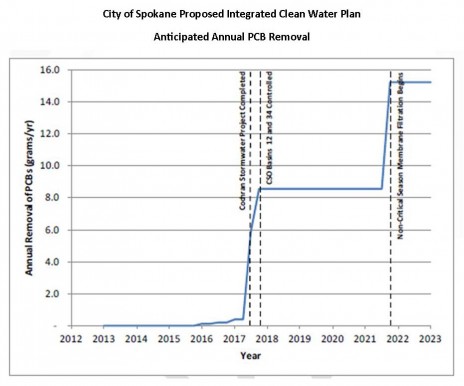Results of Spokane River fish sampling mixed
For those angling and eating their catch on the Spokane River, fish sampling results to monitor contaminants were mixed. In a report released by the Washington Department of Ecology, Spokane River results “… showed that levels of PCBs and PBDEs in fish remain elevated compared to most areas in Washington.” In addition, “Concentrations of PBDEs in mountain whitefish from the Nine Mile reach were approximately 4 to 10 times higher than in fish from other sites in the river. … In some cases, concentrations found in 2012 appear to be lower than those in 2005. For PCBs, 2 of 11 cases show a decrease, with both cases occurring in the Mission Park reach. For PBDEs, 5 of 11 cases show a decrease.” Click here for full report.
“This type of mixed report wasn’t surprising,” says the Forum’s Executive Director Andy Dunau. “While some clean-up actions have taken place since 2005, much bigger gains are coming on-line with upgrades to waste-water treatment plants. From Coeur d’Alene to Spokane, municipal investments will total over 700 million dollars. And that’s not counting investments being made by Inland Empire Paper and Kaiser Aluminum.”
Mike LaScuola, with the Spokane Regional Health District’s Environmental Resources Program, comments, “A Fish Consumption Advisory was first released by the Health District in 1995 and acknowledged by the State Department of Health in 1999. This advisory is reviewed and updated every two years. If you follow the advisory recommendations and prepare your fish to reduce exposure to contaminants that collect in the fatty parts of the fish, you will further reduce your risk and benefit from the healthy source of protein that fish provides.” Click here for the advisory.
In addition, the City of Spokane’s proposed Integrated Clean Water Plan will invest millions of dollars in infrastructure to reduce flows to the Spokane River from separated storm sewers and combined sanitary and stormwater sewers. Tanks to hold flows during large storms and low impact development infrastructure will keep contaminants from entering the river. This graph shows the anticipated yearly reduction in PCBs that will reach the river from these changes and improvements at the City’s wastewater treatment plant.
Meanwhile, the Spokane River Toxics Task Force, a group of governmental agencies, private industry, and environmental organizations, was formed in 2012 to identify and implement actions that reduce PCBs. The task force has galvanized Spokane’s identity as a leader in collaborating and solving complex water quality issues. The members share a common purpose: removing PCBs from the river, making fish safe to eat, and achieving a healthy and safe community. The task force’s comprehensive approach has informed important conversations about PCB-free purchasing, integrated clean water planning, and advanced treatment technology. These are all essential actions needed to improve the Spokane River’s health.
“We are excited that the task force is beginning a year-long study to answer important questions about PCBs in the river,” said Adriane Borgias, the Spokane River Water Quality Specialist with Ecology, “using state-of-the-art water sampling and analysis techniques to measure the extremely low levels of PCBs will give us all a better understanding of their sources and movement through the river system. And this will allow us to pinpoint opportunities and target funding for PCB reduction.”
Ecology has monitored the effects of bioaccumulative contaminants in freshwater fish statewide since 2001. To date, 400 fish tissue samples from 150 sites have been collected and assessed. In 2009, the Spokane River became part of a long-term monitoring component to assess trends for chemicals such as mercury, PCBs, and metals that are part of clean-up actions.
Said Dunau, “Getting the Spokane River fully compliant with clean water standards is going to take more than one generation to accomplish. The good news is things are and will continue to improve. As a result, the river is becoming an ever more popular place to recreate and enjoy.”

